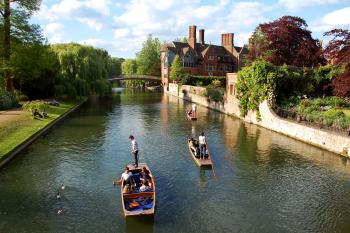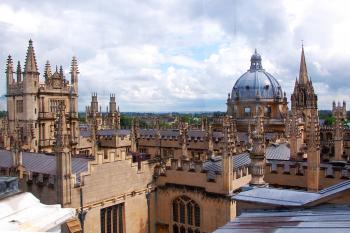Choosing between intellectual rivals: Oxford vs. Cambridge
Appears in the Online Edition, January 2019.
Cambridge and Oxford have been in a centuries-long competition as England's top two universities -- but I've always felt that seeing one is enough. The big question is: Which one?
For years, I've had it lodged in my mind that Cambridge was much better to visit than Oxford. But on a recent visit, I changed my view. Though it's a close call, I'd give an edge to bustling Oxford -- the more substantial town with plenty to see and do. Cambridge is a close second, with lovely gardens along the River Cam and a simpler, charming atmosphere.
Both towns are only an hour's train ride away from London, with Oxford to the west and Cambridge to the north, making each a fun and doable day-trip. Cambridge, with fewer accommodations, works better as a side-trip from London than as a stopover. Oxford can keep you busy sightseeing for a longer time and has plenty of good hotels -- so it's worth a longer stay. Oxford is also a stone's throw from several other charming English destinations: the Cotswolds, Stratford-upon-Avon, Warwick and Blenheim Palace. But if you really can't pick just one, there's a great bus connection between them.
Despite their fierce rivalry -- especially when it comes to rowing -- Oxford and Cambridge have many similarities. Both schools use the "collegiate system," where the colleges are mixed throughout the town; there's no sense of one secluded campus typical of many American universities. Both boast beautiful architecture and walkable town centers punctuated with convivial pubs and shops. And, of course, both have distinguished academic reputations known throughout the world.
Founded in the 11th century, the University of Oxford is the oldest university in the English-speaking world and is known for its academic achievements and stellar alumni. Its many graduates have influenced the course of Western civilization in the realms of science, literature, politics and beyond (among its amazing alumni are Margaret Thatcher, Stephen Hawking and Oscar Wilde).
But that doesn't mean that Oxford is stodgy. Although you may see professors in their traditional black robes, this is a fun, young college town filled with shopping, cheap eats, pranks and rowdy, rollicking pubs -- a mix of town and gown.
Of Oxford's colleges, Christ Church is the largest (and, some think, most pretentious). It's also the most popular stop for travelers -- in part because of its historic fame, but mostly because scenes from the Harry Potter movies were filmed here. If Middle-earth and Narnia are more to your taste, stop by The Eagle and Child pub, a five-minute walk from the city center. It's most famous for its clientele -- authors J.R.R. Tolkien and C.S. Lewis often met here.
The sightseers' Oxford is walkable and compact, and many of the streets in the center are pedestrian-only during the day. And there are more than colleges and literary connections here. The town also has a fine Norman castle-fortress and a museum of fine arts and archaeology.
The younger of the two, historic Cambridge is the epitome of a university town, with busy bikers, stately residence halls, plenty of bookshops and proud locals who can point out where the atom was first split. Originally founded in 1209 by some rebellious Oxford students, Cambridge now hosts 12,000 undergrads across 31 colleges, all with the same layout: green, monastic-type courtyards surrounded by chapels, libraries and housing.
The lively street in front of King's College, called King's Parade, is where locals gather. Nearby you'll find King's College Chapel, England's best example of Perpendicular Gothic architecture. When it was built, it had the largest single span of vaulted roof anywhere -- 2,000 tons of incredible fan vaulting, held in place by the force of gravity. If you're in town for the evening, the evensong service at King's College Chapel is a must.
For a little levity and probably more exercise than you really want, try renting one of the traditional flat-bottom boats called "punts" and pole yourself up and down the River Cam. For a more relaxed spin, join a tour with a student guide who does the punting for you. Then quench your thirst at The Eagle, a pub near King's College where the discovery of the DNA double helix was announced in 1953. With a history so rich, a drink here practically qualifies as serious sightseeing.
If your stay in England is limited, you may not want to see both towns. I recommend visiting one or the other and save time for something completely different. Whether you opt for Oxford's urban energy or Cambridge's easygoing tranquility, both offer a heady mix of history, architecture and youthful fun.
(Rick Steves (www.ricksteves.com) writes European travel guidebooks and hosts travel shows on public television and public radio. Email him at rick@ricksteves.com and follow his blog on Facebook.)


